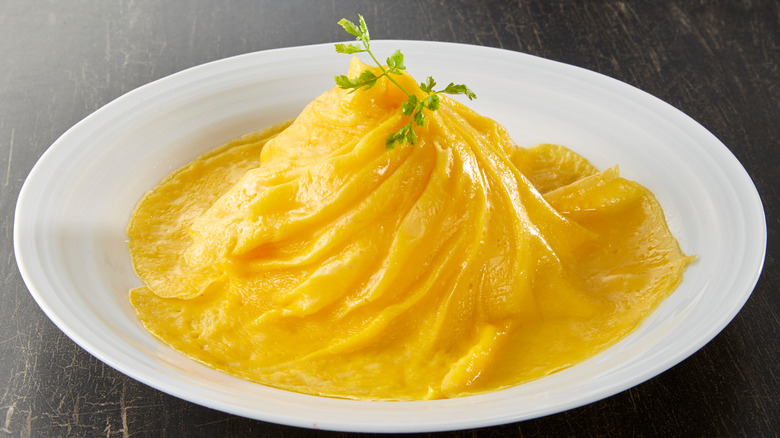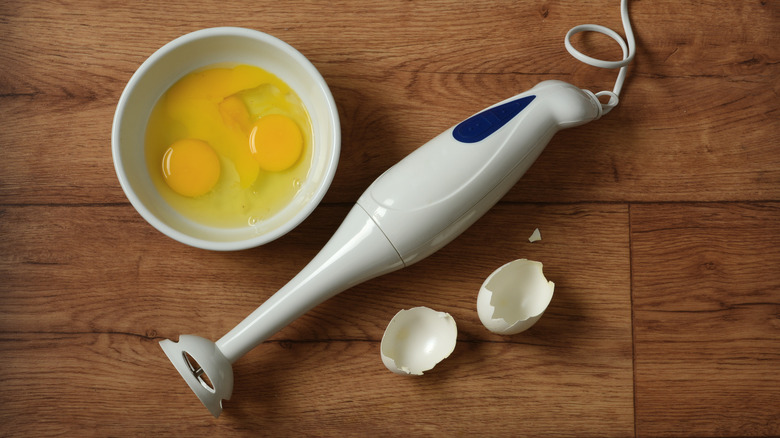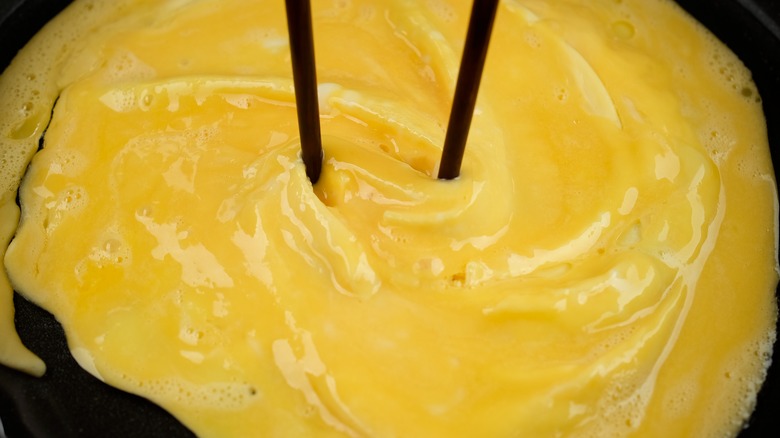The Kitchen Appliance That Guarantees A Silky Tornado Omelet
Food trends have seemingly only picked up speed since TikTok and Instagram Reels took off, and one of the Internet's favorites is the tornado omelet. You may be used to the standard diner omelet, fluffy and stuffed and folded in half, or the French omelet with its soft, scrambled curds and trifold. Maybe you've seen the Japanese tamagoyaki omelet, folded tightly on itself to create many thin layers of egg. But the Korean tornado omelet is something else entirely. More like a deconstructed omelet, the tornado omelet is a thin layer of smooth scrambled egg bunched up into a swirl and draped over a mound of filling. And it's harder than it seems — it has stumped more than a few foodies! To get it right, you need a few tools and a couple of tricks.
The most important thing in achieving a proper tornado effect in your omelet is to get the eggs incredibly smooth. No matter how hard you try, you're not going to get there with a fork and a bowl. Instead, reach for your immersion blender to really emulsify the eggs and create a silky consistency. If you don't have an immersion blender, you can whip out the old countertop blender.
Next, grab a sieve. After you've blended your eggs, pass the mixture through the sieve to remove any clumps and remaining albumen. Then, for the best results, you're going to need chopsticks and a skillet.
Two more necessary tools for the best tornado omelet
The second tool you'll need is a skillet that is heavy, small, and preferably nonstick (yes, so many caveats). Both "Fast" Ed Halmagyi of Better Homes and Gardens and Grace Elkus of The Kitchn tested many tornado omelets before finding the perfect pan, and although we don't get to see their missed tries, it's easy to imagine the frustration. Elkus swears that the pan must be small and nonstick with sloped sides — the hardest thing for her was to get the edges of the omelet to twirl properly, and a smaller pan made this more manageable. Halmagyi says his omelets didn't work until he chose a heavier pan; though he doesn't explain why, this may have to do with heat distribution.
The third tool you will want to use is a pair of chopsticks. This is how you'll create the whirl of the tornado. Elkus recommends holding them an inch apart as you spin, which can take some practice. With a few more tips, you'll be whipping up a tornado in your kitchen in no time.
Tips for getting your tornado omelet right
One of Grace Elkus's first tips for a successful tornado omelet is to get the egg mixture just right: three eggs plus 1 tablespoon of water per omelet. With two eggs the omelet tears as it spins, but four eggs create an unwieldy, too-big tornado — the water helps keep it from tearing.
What we see in both experts' videos is that the pan is scorching hot and the process moves fast. The oil in the pan is heated past a shimmer so that when the egg mix hits, it immediately starts to cook. Once it begins to bubble up a bit through the unset curd, it's time to start twirling.
To start the tornado, drag one chopstick from the edge of the set egg to the center. Repeat with the other chopstick immediately across from the first. As you twirl, rotate the pan in the opposite direction. You do not want the egg to be fully set; remaining a little soft will allow it to drape over the filling and complete the tornado effect.
As Elkus notes, the effect isn't complete unless the omelet is draped over a mound of something. In Korea, this is traditionally fried rice, shaped into a semi-sphere; it is then shrouded in the tornado and served in a moat of curry or demi-glace sauce. Any cooked filling will work: Press it into a ramekin or mise bowl and turn it out onto a plate to create the perfect tornado shape.


